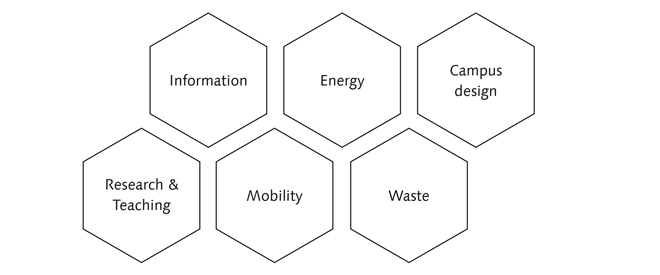Contribution to Sustainability
Sustainability is considered a guiding principle in the endeavour to shape societies of today, to facilitate the fulfilment of their legitimate interests and simultaneously secure and strengthen their future scope for development.
From the above explanations regarding the environmental aspect in research and teaching as well as the calculations on environmental performance, a very comprehensive picture of the status quo at the Bauhaus-Universität Weimar in 2019 has already emerged.
The German government’s goal of climate neutrality by 2045 has been instrumental in the Bauhaus-Universität Weimar forming its own self-image of forging ahead with efforts to reduce its CO2 emissions. In addition, per end of 2019, 69 German municipalities and cities have already declared a climate emergency, which aims to measure all future local and political decisions concerning the issue of climate.
Students at the Bauhaus-Universität Weimar also clearly expressed their opinion in November 2019. They invoked a week-long climate strike. Very constructively, their goal was not the mere suspension of courses but the substitution of courses with teaching and discussion formats on sustainability, including climate neutrality and climate justice. In December 2019, students submitted to the President of the university a list of demands for a »Climate Neutral Bauhaus-Universität Weimar«. The President referred to these demands when submitting proposals to the Senate.
For the university, this is about its own contribution to a sustainable society and the responsible use of common goods. Further measures are undoubtedly necessary in order to live up to these aspirations.
The next important steps are therefore to formulate and initiate definitive, verifiable goals, strategies and activities. For this purpose, areas of action that thematically unite the planned goals and measures are to be identified. In addition to economic and social sustainability, the areas of action in this environmental report focus primarily on the ecological orientation of the concept of sustainability. Ideally, the areas of action will have a noticeable impact on all levels of the university – i.e., on the institutional and structural level, the content and didactic level and on the level of the student world.
The contribution to sustainability at the structural level of the university as an institution is primarily focused on the careful use of finite resources in construction and business. The didactic level includes expanding the range of courses on topics relevant to climate and sustainability, as well as enabling students to successfully participate in the social debate on common goods worthy of protection. Sustainable action at the content level also includes a reflective approach to one’s own research and teaching that takes into account their social inclusion without restricting the fundamental right of academic freedom. Ecological sustainability is multifariously embedded in the student world. Many sustainability initiatives at the Bauhaus-Universität Weimar come from or are organised by students – be it by student representatives such as the StudierendenKonvent (StuKo; Student Government), the Fachschaftsräte (FSR; Faculty Student Councils) or in independent groups.
The Following areas of action for deriving definitive measures and goals for the Bauhaus-Universität Weimar are initially recommended:

Information and education
The core of this area of action is the dissemination of information on university environmental management as well as the networking and support of internal and external initiatives on environmental protection and sustainability. Improvement of environmentally friendly procurement should also be identified as a goal.
Energy
In terms of environmental performance - especially CO2 consumption by category – it is clear that a great emphasis is placed on energy. Based on optimised recording of consumption with regard to electrical and heating energy, it is necessary to determine savings potential and provide concepts for improved energy management. To this end, further support for implementation within the framework of pilot measures by the state of Thuringia is an absolute must.
Mobility
The second largest proportion of CO2 emissions is generated in connection with university related mobility. Within this area, there are numerous topics for which environmental goals and measures can be formulated; for example, with regard to business-related travel, selected means of transport, the university’s vehicle fleet, as well as in the ecological evaluation of all traffic flows of the Bauhaus-Universität Weimar.
Waste
Ziele und Maßnahmen im Handlungsfeld Abfall betreffen beispielsweise die verbesserte Trennung und Erfassung der unterschiedlichen Abfallfraktionen. Ergänzende Maßnahmen zur Steigerung der Abfallvermeidung sollen ebenso ergriffen werden.
Research and Teaching
An annual survey of courses related to ecological sustainability – which was started here – is to be regarded as the first measure in this area of action and is aimed at publicising and promoting courses on topics relevant to climate and sustainability. Furthermore, goals and measures in connection with scientific and artistic research are to be developed in future.
Campus Design
A sustainable design of the university campus can be promoted in various ways. Increasing local biodiversity in a targeted manner; promoting local rainwater infiltration; limiting and reducing the proportion of sealed surfaces on university grounds; these are but a few examples. Measures to ecologically enhance existing recreational and green spaces can observably increase the quality of time spent on campus for all members of the university.
The task of subsequent environmental reports will be to further specify the goals of the individual areas of action and to provide them with measures, responsibilities and schedules. Only in doing this will it be possible to observe progress and effectiveness in the respective areas of action in future. The introduction of process loops in which goals and measures are discussed, implemented, evaluated and in which problems are eliminated is advantageous in this connection.

